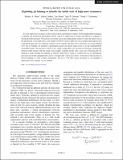| dc.contributor.author | Ebert, Markus A. | |
| dc.contributor.author | Liebler, Stefan | |
| dc.contributor.author | Tackmann, Frank J. | |
| dc.contributor.author | Tackmann, Kerstin | |
| dc.contributor.author | Zeune, Lisa | |
| dc.contributor.author | Moult, Ian James | |
| dc.contributor.author | Stewart, Iain W | |
| dc.date.accessioned | 2016-12-27T16:17:58Z | |
| dc.date.available | 2016-12-27T16:17:58Z | |
| dc.date.issued | 2016-09 | |
| dc.date.submitted | 2016-06 | |
| dc.identifier.issn | 2470-0010 | |
| dc.identifier.issn | 2470-0029 | |
| dc.identifier.uri | http://hdl.handle.net/1721.1/106143 | |
| dc.description.abstract | If a new high-mass resonance is discovered at the Large Hadron Collider, model-independent techniques to identify the production mechanism will be crucial to understand its nature and effective couplings to Standard Model particles. We present a powerful and model-independent method to infer the initial state in the production of any high-mass color-singlet system by using a tight veto on accompanying hadronic jets to divide the data into two mutually exclusive event samples (jet bins). For a resonance of several hundred GeV, the jet binning cut needed to discriminate quark and gluon initial states is in the experimentally accessible range of several tens of GeV. It also yields comparable cross sections for both bins, making this method viable already with the small event samples available shortly after a discovery. Theoretically, the method is made feasible by utilizing an effective field theory setup to compute the jet cut dependence precisely and model independently and to systematically control all sources of theoretical uncertainties in the jet binning, as well as their correlations. We use a 750 GeV scalar resonance as an example to demonstrate the viability of our method. | en_US |
| dc.description.sponsorship | United States. Dept. of Energy. Office of Nuclear Physics (Grant DE-SC0011090) | en_US |
| dc.description.sponsorship | Deutsche Forschungsgemeinschaft (Collaborative Research Center (SFB) 676 Particles, Strings and the Early Universe) | en_US |
| dc.description.sponsorship | Simons Foundation (Investigator Grant 327942) | en_US |
| dc.description.sponsorship | Netherlands Organization for Scientific Research (VEN)I Grant) | en_US |
| dc.description.sponsorship | MIT International Science and Technology Initiatives (Collaboration Grant) | en_US |
| dc.description.sponsorship | Netherlands Organization for Scientific Research (VENI Grant) | en_US |
| dc.description.sponsorship | Deutsche Forschungsgemeinschaft (Emmy-Noether Grant TA 867/1-1) | en_US |
| dc.publisher | American Physical Society | en_US |
| dc.relation.isversionof | http://dx.doi.org/10.1103/PhysRevD.94.051901 | en_US |
| dc.rights | Article is made available in accordance with the publisher's policy and may be subject to US copyright law. Please refer to the publisher's site for terms of use. | en_US |
| dc.source | American Physical Society | en_US |
| dc.title | Exploiting jet binning to identify the initial state of high-mass resonances | en_US |
| dc.type | Article | en_US |
| dc.identifier.citation | Ebert, Markus A. et al. “Exploiting Jet Binning to Identify the Initial State of High-Mass Resonances.” Physical Review D 94.5 (2016): n. pag. © 2016 American Physical Society | en_US |
| dc.contributor.department | Massachusetts Institute of Technology. Center for Theoretical Physics | en_US |
| dc.contributor.department | Massachusetts Institute of Technology. Department of Physics | en_US |
| dc.contributor.mitauthor | Moult, Ian James | |
| dc.contributor.mitauthor | Stewart, Iain W | |
| dc.relation.journal | Physical Review D | en_US |
| dc.eprint.version | Final published version | en_US |
| dc.type.uri | http://purl.org/eprint/type/JournalArticle | en_US |
| eprint.status | http://purl.org/eprint/status/PeerReviewed | en_US |
| dc.date.updated | 2016-09-28T22:00:10Z | |
| dc.language.rfc3066 | en | |
| dc.rights.holder | American Physical Society | |
| dspace.orderedauthors | Ebert, Markus A.; Liebler, Stefan; Moult, Ian; Stewart, Iain W.; Tackmann, Frank J.; Tackmann, Kerstin; Zeune, Lisa | en_US |
| dspace.embargo.terms | N | en_US |
| dc.identifier.orcid | https://orcid.org/0000-0002-4819-4081 | |
| dc.identifier.orcid | https://orcid.org/0000-0003-0248-0979 | |
| mit.license | PUBLISHER_POLICY | en_US |
